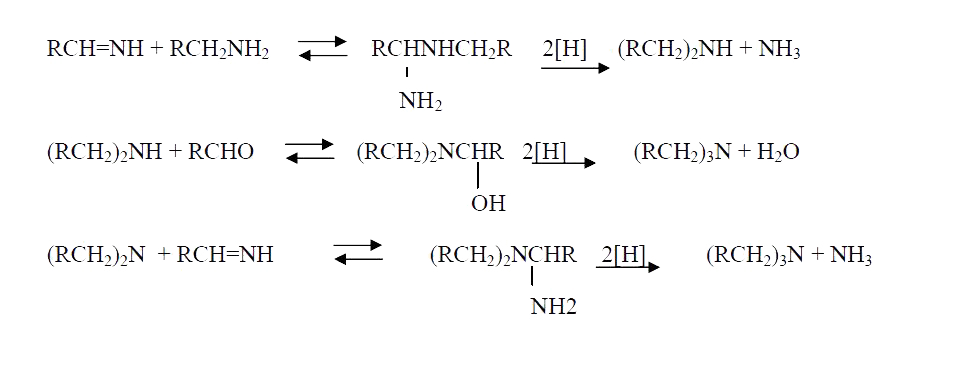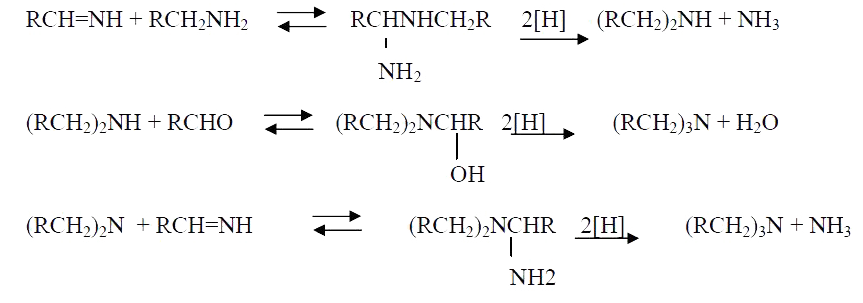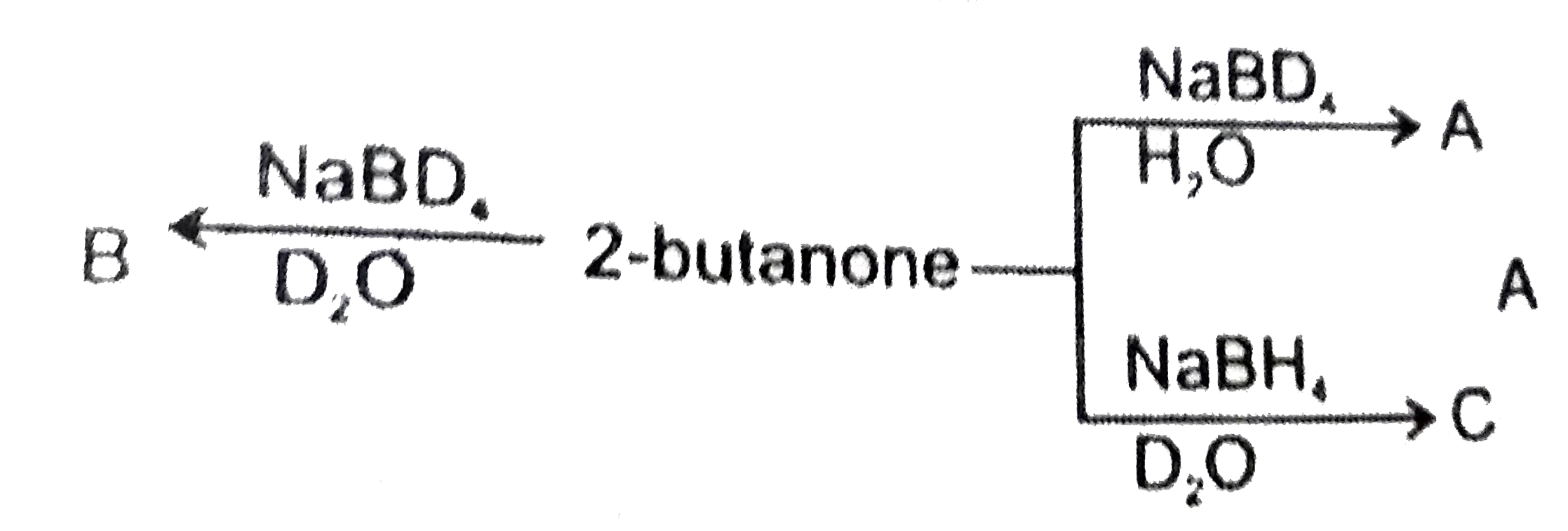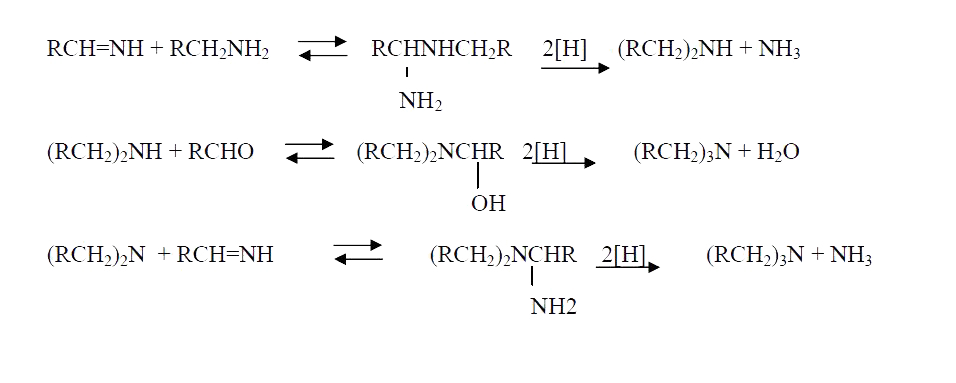Synthesise benzylamine (PhCH2NH2) by
a. Hofman degradation
b. Reductive amination
c. Alkyl halide amination
d. Gabriel method
e. Nitrile reduction .
a. PhCH2−O∣∣C−NH2Br2,NaOH−−−−−−→PhCH2NH2
b. (##KSVCHMORGP2C15S01018_S01.png width=80%><br>c.PhCH_2I underset (NH_3) overset (Excess ) (rarr) Ph CH_2 NH_2<br>d. (##KSV_CHM_ORG_P2_C15_S01_018_S02.png" width="80%">
e. Ph−C≡NLAH−−−−−→H2OPhCH2NH2.
Topper's Solved these Questions
- ORGANIC COMPOUNDS WITH FUNCTIONAL GROUPBOOK - CENGAGE CHEMISTRYCHAPTER - ORGANIC COMPOUNDS WITH FUNCTIONAL GROUPEXERCISE - Solved Examples
12 Videos
- ORGANIC COMPOUNDS WITH FUNCTIONAL GROUPBOOK - CENGAGE CHEMISTRYCHAPTER - ORGANIC COMPOUNDS WITH FUNCTIONAL GROUPEXERCISE - Exercises Subjective
21 Videos
- NUCLEAR CHEMISTRYBOOK - CENGAGE CHEMISTRYCHAPTER - NUCLEAR CHEMISTRYEXERCISE - Archives Subjective
13 Videos
- P-BLOCK GROUP 15 ELEMENTS - THE NITROGEN FAMILYBOOK - CENGAGE CHEMISTRYCHAPTER - P-BLOCK GROUP 15 ELEMENTS - THE NITROGEN FAMILYEXERCISE - Exercises Archives (Subjective)
28 Videos
Similar Questions
Write structures and IUPAC names of
(i) the amide which gives propanamine by Hoffmann bromamide reaction
(ii) the alkyl halide used in Garbriel phthalimide synthesis to give ethanamine
(iii) amine obtained by reduction of propanamide
(iv) the amine produced by the Hoffmann degradation of benzamide.
View Solution(a) Give reasons :
(i) Although-NH2 group is o/p directing in electrophilic substitution reactions, yet aniline, on nitration gives good yield of m-nitroaniline.
(ii) (CH3)2NH is more basic than (CH3)3N in an aqueous solution.
(iii) Ammonolysis of alkyl halides is not a good method to prepare pure primary amines.
(b) Distinguish between the following :
(i) CH3CH2NH2 and (CH3CH2)2NH
(ii) Aniline and CH3NH2
View Solution
Knowledge Check
Methyl amine, CH3NH2 is a week base. The expression for its ionization constant Kb is
A[CH3NH+3][OH−][CH3NH2][H2O]B[CH2NH+3][OH−][CH3NH2]C[CH3NH−][H3O+][CH3NH2]D[CH3NH2][CH3NH+3][OH−]Match column I and column II
((A)Ammolysis (p) Amine with lesser no. of carbon atom(B) Gabriel phthalimide (q) Detection of primary amine (C)Hoffmann bromide amide degradation(r) Reaction of pthalimide with KOH and R-X(D)Carbylamine reaction (s) Reaction of alkyl halides withNH3AA-s, B-r, C-p, D-qBA-p, B-q, C-r, D-sCA-r, B-s, C-p, D-qDA-s, B-r, C-q, D-pC2H5NH2 formed by reduction of
AMethyl cyanideBEthyl cyanideCAcetoneDAcetic acid
Read the passage given below and answer the following questions:
Reductive alkylation is the term applied to the process of introducing alkyl groups into ammonia or a primary or secondary amine by means of an aldehyde or ketone in the presence of a reducing agent. The present discussion is limited to those reductive alkylations in which the reducing agent is hydrogen and a catalyst or "nascent" hydrogen, usually from a metalacid combination, most of these reductive alkylations have been carried out with hydrogen and a catalyst. The principal variation excluded is that in which the reducing agent is formic acid or one of its derivatives, this modification is known as the Leuckart reaction. The process of reductive alkylation of ammonia consists in the addition of ammonia to a carbonyl compound and reduction of the addition compound or its dehydration product. The reaction usually is carried out in ethanol solution when the reduction is to be effected catalytically

Since the primary amine is formed in the presence of the aldehyde it may react in the same way as ammonia, yielding an addition compound, a Schiff's base (RCH=NCH2R) and finally, a secondary amine. Similarly, the primary amine may react with the imine, forming an addition product which also is reduced to a secondary amine Finally, the secondary amine may react with either the aldehyde or the imine to give products which are reduced to tertiary amines.

Similar reactions may occur when the carbonyl compound employed is a ketone.
(source: Emerson, W. S. (2011). The Preparation of Amines by Reductive Alkylation. Organic Reactions, 174–255. doi:10.1002/0471264180.or004.03 )
(CH3CH2CH2)2NH+CH3CH2CHO→P2[H]−−→Q
The ompound Q is :
View SolutionRead the passage given below and answer the following questions:
Reductive alkylation is the term applied to the process of introducing alkyl groups into ammonia or a primary or secondary amine by means of an aldehyde or ketone in the presence of a reducing agent. The present discussion is limited to those reductive alkylations in which the reducing agent is hydrogen and a catalyst or "nascent" hydrogen, usually from a metalacid combination, most of these reductive alkylations have been carried out with hydrogen and a catalyst. The principal variation excluded is that in which the reducing agent is formic acid or one of its derivatives, this modification is known as the Leuckart reaction. The process of reductive alkylation of ammonia consists in the addition of ammonia to a carbonyl compound and reduction of the addition compound or its dehydration product. The reaction usually is carried out in ethanol solution when the reduction is to be effected catalytically

Since the primary amine is formed in the presence of the aldehyde it may react in the same way as ammonia, yielding an addition compound, a Schiff's base (RCH=NCH2R) and finally, a secondary amine. Similarly, the primary amine may react with the imine, forming an addition product which also is reduced to a secondary amine Finally, the secondary amine may react with either the aldehyde or the imine to give products which are reduced to tertiary amines.

Similar reactions may occur when the carbonyl compound employed is a ketone.
(source: Emerson, W. S. (2011). The Preparation of Amines by Reductive Alkylation. Organic Reactions, 174–255. doi:10.1002/0471264180.or004.03 )
Reductive alkylation of ammonia by means of an aldehyde in presence of hydrogen as reducing agents results in formation of:
View SolutionConsider reduction of 2-butanone.
 A , B and C are respectively
A , B and C are respectively
View SolutionRead the passage given below and answer the following questions:
Reductive alkylation is the term applied to the process of introducing alkyl groups into ammonia or a primary or secondary amine by means of an aldehyde or ketone in the presence of a reducing agent. The present discussion is limited to those reductive alkylations in which the reducing agent is hydrogen and a catalyst or "nascent" hydrogen, usually from a metalacid combination, most of these reductive alkylations have been carried out with hydrogen and a catalyst. The principal variation excluded is that in which the reducing agent is formic acid or one of its derivatives, this modification is known as the Leuckart reaction. The process of reductive alkylation of ammonia consists in the addition of ammonia to a carbonyl compound and reduction of the addition compound or its dehydration product. The reaction usually is carried out in ethanol solution when the reduction is to be effected catalytically

Since the primary amine is formed in the presence of the aldehyde it may react in the same way as ammonia, yielding an addition compound, a Schiff's base (RCH=NCH2R) and finally, a secondary amine. Similarly, the primary amine may react with the imine, forming an addition product which also is reduced to a secondary amine Finally, the secondary amine may react with either the aldehyde or the imine to give products which are reduced to tertiary amines.

Similar reactions may occur when the carbonyl compound employed is a ketone.
(source: Emerson, W. S. (2011). The Preparation of Amines by Reductive Alkylation. Organic Reactions, 174–255. doi:10.1002/0471264180.or004.03 )
Ethanal on reaction with ammonia forms an imine (X) which on reaction with nascent hydrogen gives (Y). Identify ‘X’ and ‘Y’.
View SolutionRead the passage given below and answer the following questions:
Reductive alkylation is the term applied to the process of introducing alkyl groups into ammonia or a primary or secondary amine by means of an aldehyde or ketone in the presence of a reducing agent. The present discussion is limited to those reductive alkylations in which the reducing agent is hydrogen and a catalyst or "nascent" hydrogen, usually from a metalacid combination, most of these reductive alkylations have been carried out with hydrogen and a catalyst. The principal variation excluded is that in which the reducing agent is formic acid or one of its derivatives, this modification is known as the Leuckart reaction. The process of reductive alkylation of ammonia consists in the addition of ammonia to a carbonyl compound and reduction of the addition compound or its dehydration product. The reaction usually is carried out in ethanol solution when the reduction is to be effected catalytically

Since the primary amine is formed in the presence of the aldehyde it may react in the same way as ammonia, yielding an addition compound, a Schiff's base (RCH=NCH2R) and finally, a secondary amine. Similarly, the primary amine may react with the imine, forming an addition product which also is reduced to a secondary amine Finally, the secondary amine may react with either the aldehyde or the imine to give products which are reduced to tertiary amines.

Similar reactions may occur when the carbonyl compound employed is a ketone.
(source: Emerson, W. S. (2011). The Preparation of Amines by Reductive Alkylation. Organic Reactions, 174–255. doi:10.1002/0471264180.or004.03 )
The reaction of ammonia and its derivatives with aldehydes is called:
View Solution
